key battery Seat Cordoba 2007 Owner's Manual
[x] Cancel search | Manufacturer: SEAT, Model Year: 2007, Model line: Cordoba, Model: Seat Cordoba 2007Pages: 256, PDF Size: 7.75 MB
Page 79 of 256
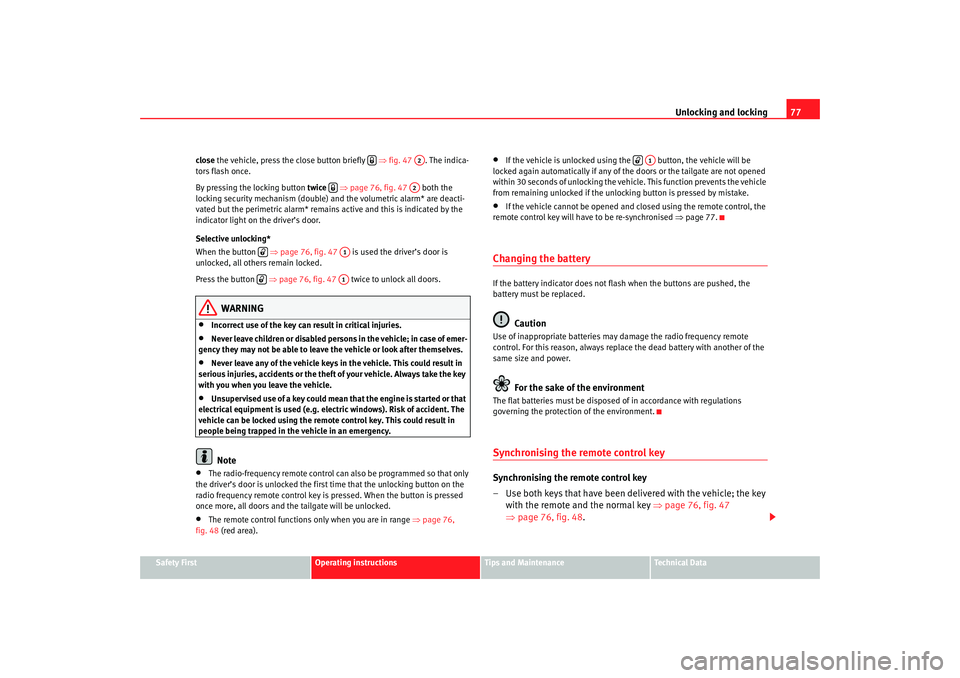
Unlocking and locking77
Safety First
Operating instructions
Tips and Maintenance
Te c h n i c a l D a t a
close
the vehicle, press the close button briefly ⇒fig. 47 . The indica-
tors flash once.
By pressing the locking button twice ⇒page 76, fig. 47 both the
locking security mechanism (double) and the volumetric alarm* are deacti-
vated but the perimetric alarm* remains active and this is indicated by the
indicator light on the driver’s door.
Selective unlocking*
When the button ⇒page 76, fig. 47 is used the driver’s door is
unlocked, all others remain locked.
Press the button ⇒page 76, fig. 47 twice to unlock all doors.
WARNING
•
Incorrect use of the key can result in critical injuries.
•
Never leave children or disabled persons in the vehicle; in case of emer-
gency they may not be able to leave the vehicle or look after themselves.
•
Never leave any of the vehicle keys in the vehicle. This could result in
serious injuries, accidents or the theft of your vehicle. Always take the key
with you when you leave the vehicle.
•
Unsupervised use of a key could me an that the engine is started or that
electrical equipment is used (e.g. elec tric windows). Risk of accident. The
vehicle can be locked using the remote control key. This could result in
people being trapped in the vehicle in an emergency.Note
•
The radio-frequency remote control ca n also be programmed so that only
the driver’s door is unlocked the first time that the unlocking button on the
radio frequency remote control key is pressed. When the button is pressed
once more, all doors and the tailgate will be unlocked.
•
The remote control functions only when you are in range ⇒page 76,
fig. 48 (red area).
•
If the vehicle is unlocked using the button, the vehicle will be
locked again automatically if any of the doors or the tailgate are not opened
within 30 seconds of unlocking the vehicle. This function prevents the vehicle
from remaining unlocked if the unlocking button is pressed by mistake.
•
If the vehicle cannot be opened and closed using the remote control, the
remote control key will have to be re-synchronised ⇒page 77.
Changing the batteryIf the battery indicator does not flash when the buttons are pushed, the
battery must be replaced.
Caution
Use of inappropriate batteries may damage the radio frequency remote
control. For this reason, always replac e the dead battery with another of the
same size and power.
For the sake of the environment
The flat batteries must be disposed of in accordance with regulations
governing the protection of the environment.Synchronising the remote control keySynchronising the remote control key
– Use both keys that have been delivered with the vehicle; the key with the remote and the normal key ⇒page 76, fig. 47
⇒ page 76, fig. 48 .
A2
A2
A1
A1
A1
cordoba_ingles_0706 Seite 77 Montag, 28. August 2006 1:18 13
Page 81 of 256
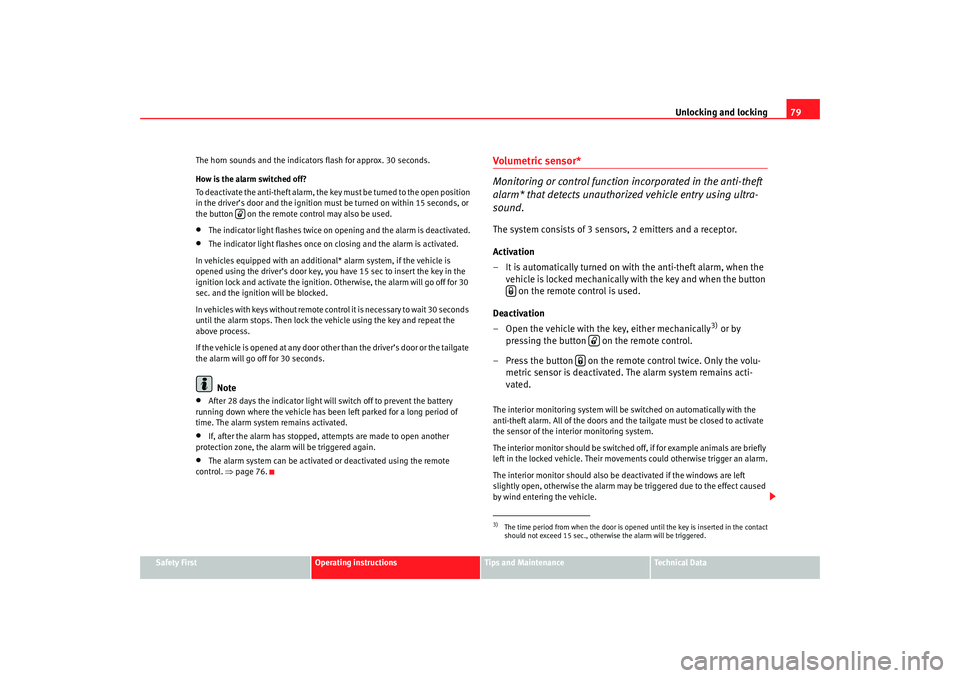
Unlocking and locking79
Safety First
Operating instructions
Tips and Maintenance
Te c h n i c a l D a t a
The horn sounds and the indicators flash for approx. 30 seconds.
How is the alarm switched off?
To deactiva
te the anti-theft alarm, the key must be turned to the open position
in the driver’s door and the ignition must be turned on within 15 seconds, or
the button on the remote control may also be used.
•
The indicator light flashes twice on opening and the alarm is deactivated.
•
The indicator light flashes once on closing and the alarm is activated.
In vehicles equipped with an additional* alarm system, if the vehicle is
opened using the driver’s door key, you have 15 sec to insert the key in the
ignition lock and activate the ignition. Otherwise, the alarm will go off for 30
sec. and the ignition will be blocked.
In vehicles with keys without remote co ntrol it is necessary to wait 30 seconds
until the alarm stops. Then lock the vehicle using the key and repeat the
above process.
If the vehicle is opened at any door other than the driver’s door or the tailgate
the alarm will go off for 30 seconds.Note
•
After 28 days the indicator light will switch off to prevent the battery
running down where the vehicle has been left parked for a long period of
time. The alarm system remains activated.
•
If, after the alarm has stopped, attempts are made to open another
protection zone, the alarm will be triggered again.
•
The alarm system can be activated or deactivated using the remote
control. ⇒page 76.
Volumetric sensor*
Monitoring or control function incorporated in the anti-theft
alarm* that detects unauthoriz ed vehicle entry using ultra-
sound.The system consists of 3 sensor s, 2 emitters and a receptor.
Activation
– It is automatically turned on with the anti-theft alarm, when the vehicle is locked mechanically with the key and when the button on the remote control is used.
Deactivation
– Open the vehicle with the key, either mechanically
3) or by
pressing the button on the remote control.
– Press the button on the remote control twice. Only the volu- metric sensor is deactivated. The alarm system remains acti-
vated.
The interior monitoring system will be switched on automatically with the
anti-theft alarm. All of the doors and the tailgate must be closed to activate
the sensor of the interior monitoring system.
The interior monitor should be switched off, if for example animals are briefly
left in the locked vehicle. Their movements could otherwise trigger an alarm.
The interior monitor should also be deactivated if the windows are left
slightly open, otherwise the alarm may be triggered due to the effect caused
by wind entering the vehicle.
3)The time period from when the door is opened until the key is inserted in the contact
should not exceed 15 sec., otherwise the alarm will be triggered.
cordoba_ingles_0706 Seite 79 Montag, 28. August 2006 1:18 13
Page 86 of 256

Unlocking and locking
84
– Use the key to lock the vehicle from outside and hold the key in
the lock position for at least one second. The one-touch function
is now ready for operation.The buttons ⇒page 82, fig. 51 and have two levels for opening the
window and two for closing it. This makes it easier to open or close windows
to the desired position.
One-touch closing does not work when the ignition has been switched off,
even if the key is in the ignition.
The automatic open and close function will not work if the battery has been
temporarily disconnected, or if the batter y is flat. The function then has to be
reactivated.
The one-touch function and roll-back fu nction will not work if there is a
malfunction in the electric windows. Contact an Authorised Service Centre.Roll-back function
The windows have a roll-back function. This reduces the risk
of injuries when the windows are closing.•
If a window is obstructed when closing automatically, the window stops
at this point and lowers immediately ⇒.
•
If this happens, check immediately (within 10 seconds) why the window
could not be closed before attempting to close it again. After 10 seconds the
normal automatic function resumes.
•
If the window is still obstructed, the window stops at this point.
•
If there is no obvious reason why the window cannot be closed, try to
close it again within five seconds.
If you wait longer than 5 - 10 seconds, the window will open fully when you
operate one of the buttons. On e-touch closing is reactivated. The one-touch function and roll-back function will not work if there is a
malfunction in the electric windows.
Contact an Authorised Service Centre.
WARNING
•
Incorrect use of the electric windows can result in injury.
•
Always take the key with you when leaving the vehicle, even if you only
intend to be gone for a short time. Please ensure that children are never left
unsupervised in the vehicle.
•
The electric windows will work unti l the key has been removed from the
ignition and one of the front doors has been opened.
•
Never close the tailgate without observing and ensuring it is clear, to do
otherwise could cause serious injury to you and others. Make sure that no
one is in the path of a window.
•
Never allow people to remain in the vehicle when you close the vehicle
from the outside. The windows cannot be opened even in an emergency.Note
The roll-back function is deactivate d if the windows are closed from the
outside of the vehicle using the ignition key for convenience closing
⇒ page 84.Convenience opening and closing* Using the door lock
– Hold the key in the door lock of the driver door in either the
locking or the unlocking position until all windows are either
opened or closed.
– Release the key to interrupt this function.
A1
A2
cordoba_ingles_0706 Seite 84 Montag, 28. August 2006 1:18 13
Page 92 of 256

Lights and visibility
90
7. Always take the vehicle key with you when you leave the vehicle.You should switch on the hazard warning lights to warn other road users, for
instance when:•
reaching the tail end of a traffic jam
•
there is an emergency
•
your vehicle breaks down due to a technical defect
•
you are towing another vehicle or your vehicle is being towed.
All turn signals flash simultaneously when the hazard warning lights are
switched on. That is that the two turn signal indicator lamps
and the
indicator lamp in the switch
will flash at the same time. The hazard
warning lights also work when the ignition is switched off.
WARNING
•
The risk of an accident increases if your vehicle breaks down. Always
use the hazard warning lights and a warning triangle to draw the attention
of other road users to your stationary vehicle.
•
Never park where the catalytic converter could come into contact with
inflammable materials under the vehicle, for example dry grass or spilt
petrol. This could start a fire!Note
•
The battery will run down if the hazard warning lights are left on for a long
time, even if the ignition is switched off.
•
The use of the hazard warning lights de scribed here is subject to the rele-
vant statutory requirements.
Turn signal and main beam headlight lever
The turn signal and main beam lever also operates the
parking lights and the headlight flasher.The turn signal and main beam headlight lever has the following
functions:
Switching on the turn signals
– Move the lever all the way up ⇒fig. 59 to indicate right , and
all the way down to indicate left.
Signalling a lane change
– Push the lever up or down to the point where you incur resistance and then release the lever. The turn signal will flash
several times. The corresponding warning lamp will also flash.
Fig. 59 Turn signal and
main beam headlight
lever
A1
A2A1
A2
cordoba_ingles_0706 Seite 90 Montag, 28. August 2006 1:18 13
Page 94 of 256
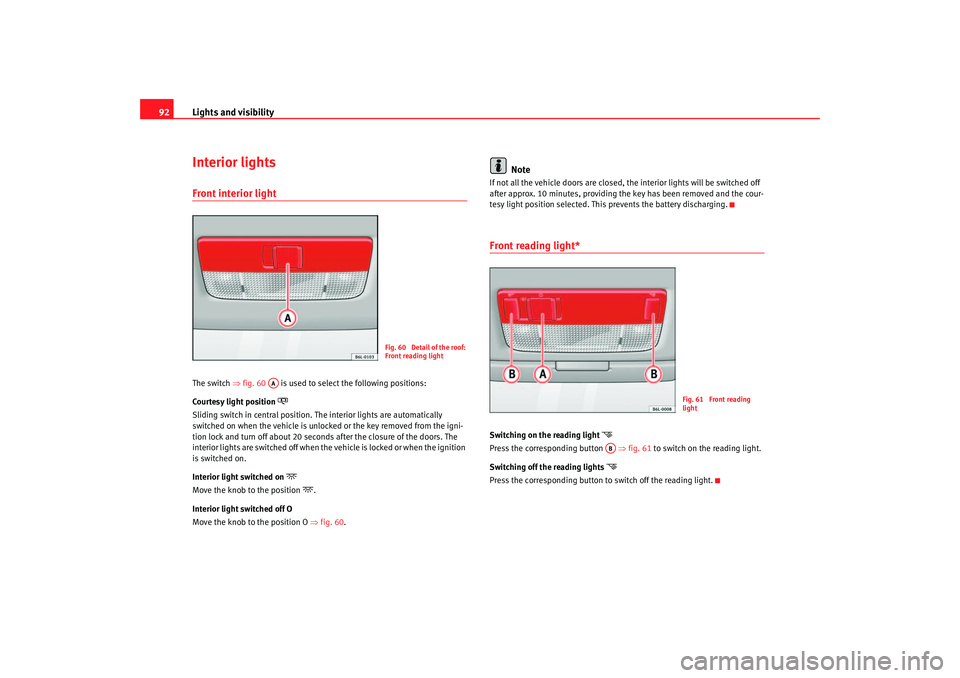
Lights and visibility
92Interior lightsFront interior light The switch ⇒fig. 60 is used to select the following positions:
Courtesy light position
Sliding switch in central position. The interior lights are automatica lly
switched on when the vehicle is unlocked or the key removed from the igni-
tion lock and turn off about 20 seconds after the closure of the doors. The
interior lights are switched off when the vehicle is locked or when the ignition
is switched on.
Interior light switched on
Move the knob to the position
.
Interior light switched off O
Move the knob to the position O ⇒fig. 60 .
Note
If not all the vehicle doors are closed, the interior lights will be switched off
after approx. 10 minutes, providing the key has been removed and the cour-
tesy light position selected. This prevents the battery discharging.Front reading light*Switching on the reading light
Press the corresponding button ⇒fig. 61 to switch on the reading light.
Switching off the reading lights
Press the corresponding button to switch off the reading light.
Fig. 60 Detail of the roof:
Front reading light
AA
Fig. 61 Front reading
light
AB
cordoba_ingles_0706 Seite 92 Montag, 28. August 2006 1:18 13
Page 112 of 256
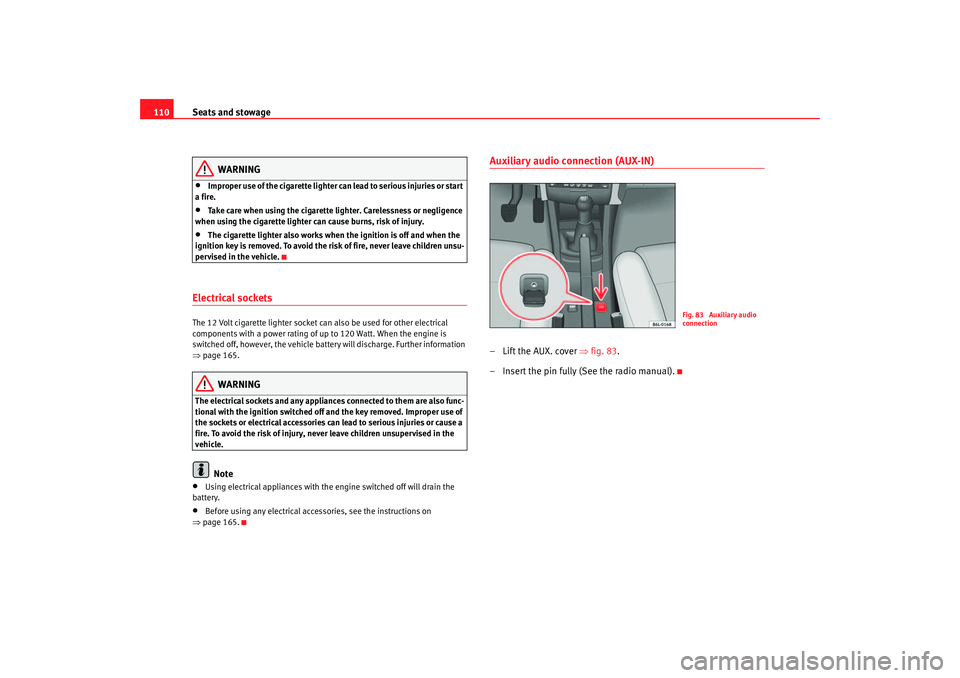
Seats and stowage
110
WARNING
•
Improper use of the cigarette lighter can lead to serious injuries or start
a fire.
•
Take care when using the cigarette lighter. Carelessness or negligence
when using the cigarette lighter can cause burns, risk of injury.
•
The cigarette lighter also works when the ignition is off and when the
ignition key is removed. To avoid the risk of fire, never leave children unsu-
pervised in the vehicle.
Electrical sockets The 12 Volt cigarette lighter socket can also be used for other electrical
components with a power rating of up to 120 Watt. When the engine is
switched off, however, the vehicle battery will discharge. Further information
⇒ page 165.
WARNING
The electrical sockets and any appli ances connected to them are also func-
tional with the ignition switched off and the key removed. Improper use of
the sockets or electrical accessories can lead to serious injuries or cause a
fire. To avoid the risk of injury, never leave children unsupervised in the
vehicle.
Note
•
Using electrical appliances with the engine switched off will drain the
battery.
•
Before using any electrical accessories, see the instructions on
⇒ page 165.
Auxiliary audio connection (AUX-IN)– Lift the AUX. cover ⇒fig. 83 .
– Insert the pin fully (See the radio manual).
Fig. 83 Auxiliary audio
connection
cordoba_ingles_0706 Seite 110 Montag, 28. August 2006 1:18 13
Page 131 of 256
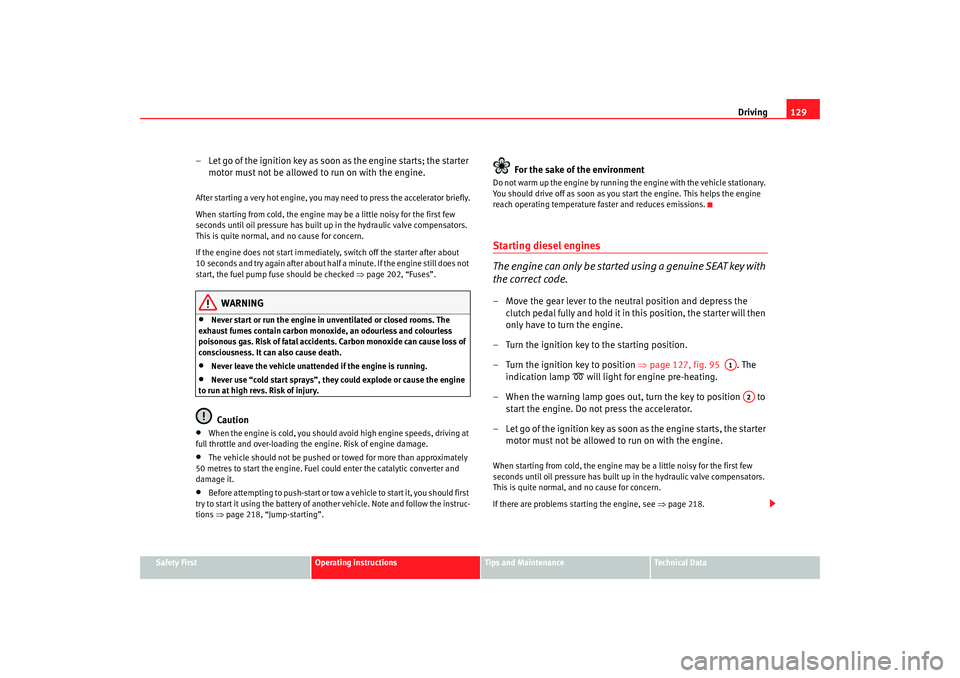
Driving129
Safety First
Operating instructions
Tips and Maintenance
Te c h n i c a l D a t a
– Let go of the ignition key as soon as the engine starts; the starter
motor must not be allowed to run on with the engine.After starting a very hot e ngine, you may need to pres s the accelerator briefly.
When starting from cold, the engine ma y be a little noisy for the first few
seconds until oil pressure has built up in the hydraulic valve compensators.
This is quite normal, and no cause for concern.
If the engine does not start immediatel y, switch off the starter after about
10 seconds and try again after about half a minute. If the engine still does not
start, the fuel pump fuse should be checked ⇒page 202, “Fuses”.
WARNING
•
Never start or run the engine in unventilated or closed rooms. The
exhaust fumes contain carbon monoxide, an odourless and colourless
poisonous gas. Risk of fatal accidents. Carbon monoxide can cause loss of
consciousness. It can also cause death.
•
Never leave the vehicle unattended if the engine is running.
•
Never use “cold start sprays”, they could explode or cause the engine
to run at high revs. Risk of injury.Caution
•
When the engine is cold, you should avo id high engine speeds, driving at
full throttle and over-loading th e engine. Risk of engine damage.
•
The vehicle should not be pushed or towed for more than approximately
50 metres to start the engine. Fuel could enter the catalytic converter and
damage it.
•
Before attempting to push-start or tow a vehicle to start it, you should first
try to start it using the battery of another vehicle. Note and follow the instruc-
tions ⇒ page 218, “Jump-starting”.
For the sake of the environment
Do not warm up the engine by running the engine with the vehicle stationary.
You should drive off as soon as you start the engine. This helps the engine
reach operating temperature faster and reduces emissions.Starting diesel engines
The engine can only be started using a genuine SEAT key with
the correct code.– Move the gear lever to the neutral position and depress the clutch pedal fully and hold it in this position, the starter will then
only have to turn the engine.
– Turn the ignition key to the starting position.
– Turn the ignition key to position ⇒page 127, fig. 95 . The
indication lamp
will light for engine pre-heating.
– When the warning lamp goes out, turn the key to position to start the engine. Do not press the accelerator.
– Let go of the ignition key as soon as the engine starts, the starter motor must not be allowed to run on with the engine.
When starting from cold, the engine ma y be a little noisy for the first few
seconds until oil pressure has built up in the hydraulic valve compensators.
This is quite normal, and no cause for concern.
If there are problems starting the engine, see ⇒page 218.
A1
A2
cordoba_ingles_0706 Seite 129 Montag, 28. August 2006 1:18 13
Page 132 of 256
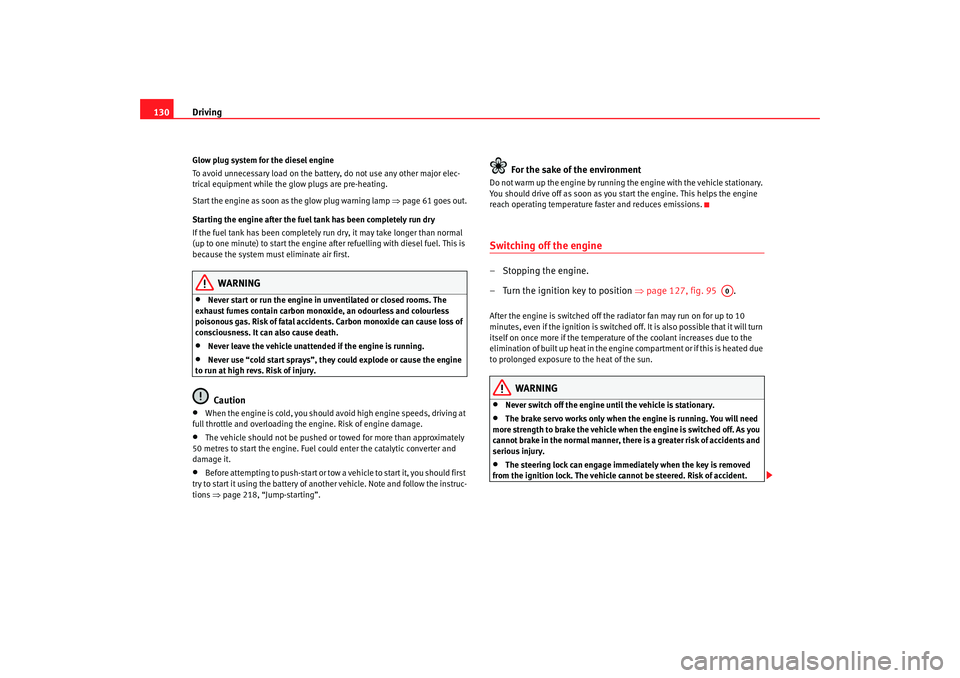
Driving
130Glow plug system for the diesel engine
To avoid unnecessary load on the battery, do not use any other major elec-
trical equipment while the glow plugs are pre-heating.
Start the engine as soon as the glow plug warning lamp ⇒page 61 goes out.
Starting the engine after the fuel tank has been completely run dry
If the fuel tank has been completely run dry, it may take longer than normal
(up to one minute) to start the engine afte r refuelling with diesel fuel. This is
because the system must eliminate air first.
WARNING
•
Never start or run the engine in un ventilated or closed rooms. The
exhaust fumes contain carbon mono xide, an odourless and colourless
poisonous gas. Risk of fatal accidents. Carbon monoxide can cause loss of
consciousness. It can also cause death.
•
Never leave the vehicle unattended if the engine is running.
•
Never use “cold start sprays”, they could explode or cause the engine
to run at high revs. Risk of injury.Caution
•
When the engine is cold, you should av oid high engine speeds, driving at
full throttle and over loading the engine. Risk of engine damage.
•
The vehicle should not be pushed or towed for more than approximately
50 metres to start the engine. Fuel could enter the catalytic converter and
damage it.
•
Before attempting to push-start or tow a vehicle to start it, you should first
try to start it using the battery of another vehicle. Note and follow the instruc-
tions ⇒page 218, “Jump-starting”.
For the sake of the environment
Do not warm up the engine by running th e engine with the vehicle stationary.
You should drive off as soon as you start the engine. This helps the engine
reach operating temperature faster and reduces emissions.Switching off the engine– Stopping the engine.
– Turn the ignition key to position ⇒page 127, fig. 95 .After the engine is switched off the radiator fan may run on for up to 10
minutes, even if the ignition is switched of f. It is also possible that it will turn
itself on once more if the temperature of the coolant increases due to the
elimination of built up heat in the engine compartment or if this is heated due
to prolonged exposure to the heat of the sun.
WARNING
•
Never switch off the engine until the vehicle is stationary.
•
The brake servo works only when the engine is running. You will need
more strength to brake the vehicle when the engine is switched off. As you
cannot brake in the normal manner, there is a greater risk of accidents and
serious injury.
•
The steering lock can engage immediately when the key is removed
from the ignition lock. The vehicle cannot be steered. Risk of accident.
A0
cordoba_ingles_0706 Seite 130 Montag, 28. August 2006 1:18 13
Page 175 of 256
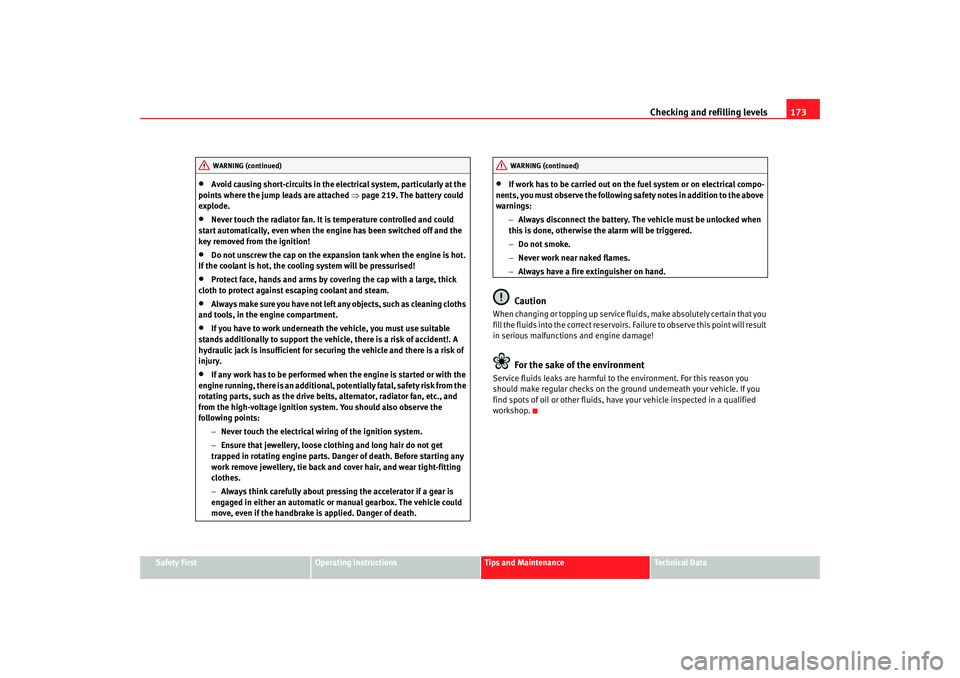
Checking and refilling levels173
Safety First
Operating instructions
Tips and Maintenance
Te c h n i c a l D a t a
•
Avoid causing short-circuits in the electrical system, particularly at the
points where the jump leads are attached ⇒page 219. The battery could
explode.
•
Never touch the radiator fan. It is temperature controlled and could
start automatically, even when the engine has been switched off and the
key removed from the ignition!
•
Do not unscrew the cap on the expansion tank when the engine is hot.
If the coolant is hot, the cooling system will be pressurised!
•
Protect face, hands and arms by covering the cap with a large, thick
cloth to protect against escaping coolant and steam.
•
Always make sure you have not left any objects, such as cleaning cloths
and tools, in the engine compartment.
•
If you have to work underneath the vehicle, you must use suitable
stands additionally to support the vehicle, there is a risk of accident!. A
hydraulic jack is insufficient for securing the vehicle and there is a risk of
injury.
•
If any work has to be performed when the engine is started or with the
engine running, there is an additional, pote ntially fatal, safety risk from the
rotating parts, such as the drive belts, alternator, radiator fan, etc., and
from the high-voltage ignition syst em. You should also observe the
following points:
−Never touch the electrical wiring of the ignition system.
− Ensure that jewellery, loose clothing and long hair do not get
trapped in rotating engine parts. Danger of death. Before starting any
work remove jewellery, tie back and cover hair, and wear tight-fitting
clothes.
− Always think carefully about pressing the accelerator if a gear is
engaged in either an automatic or manual gearbox. The vehicle could
move, even if the handbrake is applied. Danger of death.
•
If work has to be carried out on the fuel system or on electrical compo-
nents, you must observe the following sa fety notes in addition to the above
warnings:
−Always disconnect the battery. The vehicle must be unlocked when
this is done, otherwise the alarm will be triggered.
− Do not smoke.
− Never work near naked flames.
− Always have a fire extinguisher on hand.Caution
When changing or topping up service fluids, make absolutely certain that you
fill the fluids into the correct reservoirs. Failure to observe this point will result
in serious malfunctions and engine damage!
For the sake of the environment
Service fluids leaks are harmful to the environment. For this reason you
should make regular checks on the ground underneath your vehicle. If you
find spots of oil or other fluids, have your vehicle inspected in a qualified
workshop.
WARNING (continued)
WARNING (continued)
cordoba_ingles_0706 Seite 173 Montag, 28. August 2006 1:18 13
Page 251 of 256
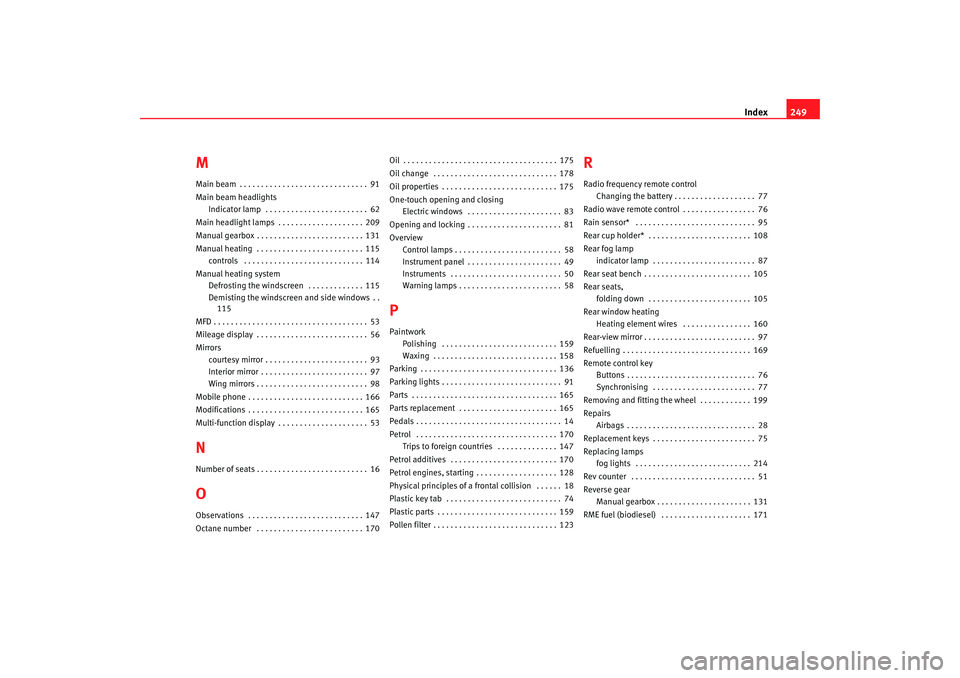
Index249
MMain beam . . . . . . . . . . . . . . . . . . . . . . . . . . . . . . 91
Main beam headlights
Indicator lamp . . . . . . . . . . . . . . . . . . . . . . . . 62
Main headlight lamps . . . . . . . . . . . . . . . . . . . . 209
Manual gearbox . . . . . . . . . . . . . . . . . . . . . . . . . 131
Manual heating . . . . . . . . . . . . . . . . . . . . . . . . . 115 controls . . . . . . . . . . . . . . . . . . . . . . . . . . . . 114
Manual heating system Defrosting the windscreen . . . . . . . . . . . . . 115
Demisting the windscreen and side windows . .115
MFD . . . . . . . . . . . . . . . . . . . . . . . . . . . . . . . . . . . . 53
Mileage display . . . . . . . . . . . . . . . . . . . . . . . . . . 56
Mirrors courtesy mirror . . . . . . . . . . . . . . . . . . . . . . . . 93
Interior mirror . . . . . . . . . . . . . . . . . . . . . . . . . 97
Wing mirrors . . . . . . . . . . . . . . . . . . . . . . . . . . 98
Mobile phone . . . . . . . . . . . . . . . . . . . . . . . . . . . 166
Modifications . . . . . . . . . . . . . . . . . . . . . . . . . . . 165
Multi-function display . . . . . . . . . . . . . . . . . . . . . 53NNumber of seats . . . . . . . . . . . . . . . . . . . . . . . . . . 16OObservations . . . . . . . . . . . . . . . . . . . . . . . . . . . 147
Octane number . . . . . . . . . . . . . . . . . . . . . . . . . 170 Oil . . . . . . . . . . . . . . . . . . . . . . . . . . . . . . . . . . . . 175
Oil change . . . . . . . . . . . . . . . . . . . . . . . . . . . . . 178
Oil properties . . . . . . . . . . . . . . . . . . . . . . . . . . . 175
One-touch opening and closing
Electric windows . . . . . . . . . . . . . . . . . . . . . . 83
Opening and locking . . . . . . . . . . . . . . . . . . . . . . 81
Overview Control lamps . . . . . . . . . . . . . . . . . . . . . . . . . 58
Instrument panel . . . . . . . . . . . . . . . . . . . . . . 49
Instruments . . . . . . . . . . . . . . . . . . . . . . . . . . 50
Warning lamps . . . . . . . . . . . . . . . . . . . . . . . . 58
PPaintworkPolishing . . . . . . . . . . . . . . . . . . . . . . . . . . . 159
Waxing . . . . . . . . . . . . . . . . . . . . . . . . . . . . . 158
Parking . . . . . . . . . . . . . . . . . . . . . . . . . . . . . . . . 136
Parking lights . . . . . . . . . . . . . . . . . . . . . . . . . . . . 91
Parts . . . . . . . . . . . . . . . . . . . . . . . . . . . . . . . . . . 165
Parts replacement . . . . . . . . . . . . . . . . . . . . . . . 165
Pedals . . . . . . . . . . . . . . . . . . . . . . . . . . . . . . . . . . 14
Petrol . . . . . . . . . . . . . . . . . . . . . . . . . . . . . . . . . 170 Trips to foreign countries . . . . . . . . . . . . . . 147
Petrol additives . . . . . . . . . . . . . . . . . . . . . . . . . 170
Petrol engines, starting . . . . . . . . . . . . . . . . . . . 128
Physical principles of a frontal collision . . . . . . 18
Plastic key tab . . . . . . . . . . . . . . . . . . . . . . . . . . . 74
Plastic parts . . . . . . . . . . . . . . . . . . . . . . . . . . . . 159
Pollen filter . . . . . . . . . . . . . . . . . . . . . . . . . . . . . 123
RRadio frequency remote control Changing the battery . . . . . . . . . . . . . . . . . . . 77
Radio wave remote control . . . . . . . . . . . . . . . . . 76
Rain sensor* . . . . . . . . . . . . . . . . . . . . . . . . . . . . 95
Rear cup holder* . . . . . . . . . . . . . . . . . . . . . . . . 108
Rear fog lamp indicator lamp . . . . . . . . . . . . . . . . . . . . . . . . 87
Rear seat bench . . . . . . . . . . . . . . . . . . . . . . . . . 105
Rear seats, folding down . . . . . . . . . . . . . . . . . . . . . . . . 105
Rear window heating Heating element wires . . . . . . . . . . . . . . . . 160
Rear-view mirror . . . . . . . . . . . . . . . . . . . . . . . . . . 97
Refuelling . . . . . . . . . . . . . . . . . . . . . . . . . . . . . . 169
Remote control key Buttons . . . . . . . . . . . . . . . . . . . . . . . . . . . . . . 76
Synchronising . . . . . . . . . . . . . . . . . . . . . . . . 77
Removing and fitting the wheel . . . . . . . . . . . . 199
Repairs Airbags . . . . . . . . . . . . . . . . . . . . . . . . . . . . . . 28
Replacement keys . . . . . . . . . . . . . . . . . . . . . . . . 75
Replacing lamps fog lights . . . . . . . . . . . . . . . . . . . . . . . . . . . 214
Rev counter . . . . . . . . . . . . . . . . . . . . . . . . . . . . . 51
Reverse gear Manual gearbox . . . . . . . . . . . . . . . . . . . . . . 131
RME fuel (biodiesel) . . . . . . . . . . . . . . . . . . . . . 171
cordoba_ingles_0706 Seite 249 Montag, 28. August 2006 1:18 13